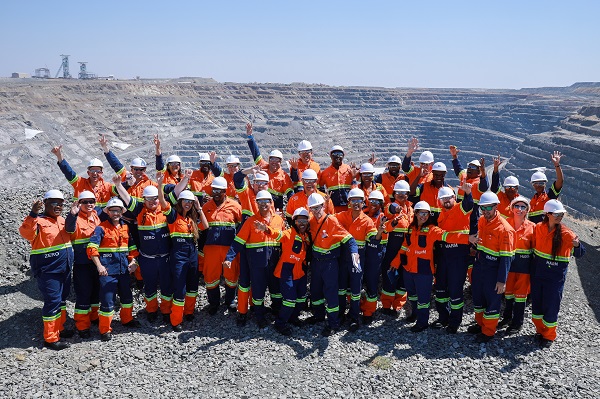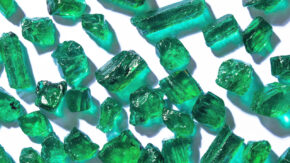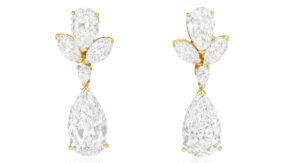RAPAPORT… If anyone in the industry wanted to know how to transform a diamond
business and safeguard its future, they might do well to speak to the 25
members of the Young Diamantaires group who went on last week’s mission to
South Africa.
The delegates from 10 countries included a jeweler who set
up a museum to boost interest in gems, another who began offering lab-grown
diamonds, and several social-media buffs. This reporter was not the only
participant who sat at the back of the bus receiving Instagram lessons from true
millennials.
Young Diamantaires came into being in 2016, when Rami Baron,
chairman of the promotions committee for the World Federation of Diamond
Bourses (WFDB), saw the need to help the new generation of industry members
connect. He set up a WhatsApp group — which now has more than 200 members — and
has organized meetings at trade shows. The oversubscribed visit to De Beers’
Venetia mine was the most ambitious plan yet, involving a day at the site,
excursions to a local school and a nearby national park, and an opportunity to
meet businesses De Beers supports in the surrounding area.
Listen to an interview with Rami Baron here (article continues below):
The strong consensus on the trip was that mining companies
need to grant this sort of access to people who are interested, and not just
those with a direct commercial connection to the operations. De Beers has often
welcomed clients at its mines (and once hosted Kim Kardashian at the Jwaneng
deposit in Botswana), but the members of the Young Diamantaires were in a
different category. Many of them were looking to learn more about the industry,
and bring back knowledge they could use to help sell diamonds in their or their
clients’ retail stores.
“People wanted to be secretive about what goes on in a mine.
But I have seen huge change in this,” said Prernaa Makharia, an India-based
jewelry blogger and influencer, and one of the volunteer social-media tutors.
“[Companies] have started believing in the concept of bringing awareness to
consumers about what goes on behind the scenes.”
For instance, the group met mining workers who seemed happy
in their jobs, experienced the stringent safety rules De Beers enforces at
Venetia, and were able to ask mine managers about the operational details. They
also learned about the current expansion from open-pit to underground mining,
which will ensure rough supply through to 2046 — by which time several
generations of diamond dealers and consumers will have come and gone.
De Beers also arranged a visit to one of the 19 local
schools the company funds, and invited some nearby businesses — which De Beers
also supports — to display their merchandise at the lodge where the group was
staying. After all, modern consumers increasingly care about the social good
associated with products, and want real assurances about the provenance of
diamonds.
“Where they do these things, other mining companies are
bound to follow,” said Kealeboga Pule, founder and managing director of
Johannesburg-based Nungu Diamonds, who initiated and helped organize the trip. “They’re
realizing the need to be more open.”
The three days were also an
opportunity to devise ways of helping local people in South Africa, and
boosting sales at home. One evening, after the group had visited the De
Beers-sponsored Renaissance Secondary School in Musina, in the northernmost
part of the country, Baron sat the group around a campfire to discuss how they
could raise $140,000 to fund a library and cafeteria for the pupils.
Under a baobab, the region’s
protected “upside-down” tree, they debated the details of how to find the
money, but one thing kept coming up: The industry has an ethical and commercial
imperative to get involved in these local projects and create a story for
consumers. (If they want another narrative, they might highlight the work De
Beers has done to transplant baobabs when mine work has forced it to uproot
them.)
“[The campfire discussion] sparked
a desire and determination to make a change and to contribute,” Baron noted.
“The highlights have been shared with [De Beers] executives, who could see the
rawness of emotion we all experienced and our determination to contribute and
make a difference.”
Young Diamantaires is now
considering how it can create export opportunities for local diamond cutters in
South Africa through an arrangement with Australia, where Baron is based. It
also plans to expand the group through a website and, potentially, by launching
global chapters, the founder added.
The participants know they have a
difficult task reforming the wider industry. Attitudes in the trade are
changing slowly, but there still needs to be a shift in the way people approach
new ideas and younger trade members, they argued. Many older diamond dealers
believe the current downturn is simply another dip that will end with an
upturn, but this is incorrect, noted Alain Zlayet, CEO and founder of Antwerp-based
Zlayet & Sons Diamonds.
“We are the ones who are thinking
and talking and researching in a new way, like the millennials,” Zlayet
explained. “They’ve understood we are a source of information for [institutions
such as the WFDB]. They tap us.”
The reporter was a guest of De Beers.
Main image: The group at the Venetia mine. Below: The campfire discussion under a baobab tree. (Simphiwe Nkwali/De Beers)



